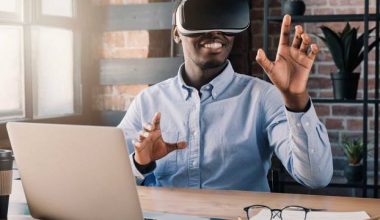
Dry mouth. Increased perspiration. Nausea and a feeling of panic. Increased blood pressure.
Sound familiar? These sensations are some of the symptoms of glossophobia, the fear of public speaking, which is the most common “social fear.” Although the idea of public speaking may bring back memories of high school presentations gone wrong, virtual reality (VR) can help learners overcome their anxiety and become skilled public speakers which, in addition to advancing their professional development, is good for business.
A Virtual Solution to a Real Fear
VR exposure therapy is often used in therapy to help people overcome their fears (e.g., claustrophobia), as it can provide stimuli for patients who have difficulty imagining scenes and/or are “too phobic” to experience situations in “real life.” Sophie Thompson, co-founder of VirtualSpeech, a VR training platform and app, says that VR is effective in evoking a “fear response” in a controlled environment. “People who fear public speaking typically feel fear in front of a virtual audience — but it will be at a manageable level rather than total avoidance or severe panic,” she explains.
When learners practice public speaking in VR, they can tell themselves, “I know this isn’t real,” but because the simulations are realistic, they can still practice public speaking, says Dr. Kristopher Blom, CEO and head of research at Virtual Human Technologies. Dan O’Brien, head of VIVE Enterprise Solutions, agrees, adding, “Traditional preparation tactics, such as third-person recording[s], speaking in front of a mirror, or practicing in front of family and friends, are rarely effective and fail to give a true impression of speaking to a crowd.”
Unlike traditional public speaking training, VR can prepare learners for unpredictable scenarios that may occur when giving a speech, such as technical issues or a disruptive audience. While these situations may not throw experienced speakers off their game, they can cause novice speakers to “freeze up,” Blom says. Training professionals should prepare learners for these unexpected obstacles in the virtual environment so they can better navigate them in the real one.
VR-based public speaking training programs also offer learners objective feedback. Through eye-tracking technology, VR can give learners “unprecedented reporting and analytics” on their performance, O’Brien says. “Individual speakers gain valuable feedback into different aspects of their performance, such as how much time is spent looking at audience members or elsewhere in the room.” Further, eye-tracking technology can determine if speakers are relying too much on their presentations slides, notecards or teleprompters and can even track the speed of eye movement and blink rate, he says.
Other emerging technologies are making their way into VR-based public speaking training as well. For example, Thompson says, “The VirtualSpeech app uses machine learning and AI to measure and provide instant feedback to the user. Using speech-to-text analysis and other technology, we provide the user with feedback on their pace of speaking, use of hesitation words, volume, eye contact performance, listenability score, keywords spoken and more.”
Although VR’s data-driven insights can benefit learners and the organization, training professionals must keep the “privacy and protection” of learners’ data top of mind to ensure they’re “comfortable and confident” using VR solutions, O’Brien says. For VIVE, this means working closely with developers and businesses to implement best practices around protecting people and their data.
By providing a safe environment for learners to practice public speaking, and giving them actionable feedback through advanced technologies, VR can sharpen learners’ public speaking skills. But how can it benefit the bottom line?
The ROI of Public Speaking Training
Employees in today’s corporate environment need public speaking skills more than one might think. After all, these skills are rooted in effective communication, which is vital for organizational success. Whether it’s giving a major presentation on behalf of the company or voicing their ideas during an internal meeting, most employees will need public speaking skills at some point in their career, especially as they move into leadership positions.
Blom says organizations should invest in public speaking training because anytime an employee is speaking publicly, it’s a reflection of the organization’s reputation — which can have a major impact on business results. In addition to developing more skilled speakers to represent the company, VR-based public speaking training can uncover insights on learners’ behavior, engagement and decision processes, O’Brien says.
Ultimately, Thompson says, “Communication skills are essential to a collaborative and inclusive workforce.” And, as companies continue to embrace automation, “It’s these key skills which make us human, which will likely become increasingly important.” VR offers a way for organizations to ensure their employees have the public speaking skills they need to succeed. As a result, employees can better represent their organizations, advance their professional development, and overcome glossophobia once and for all.







